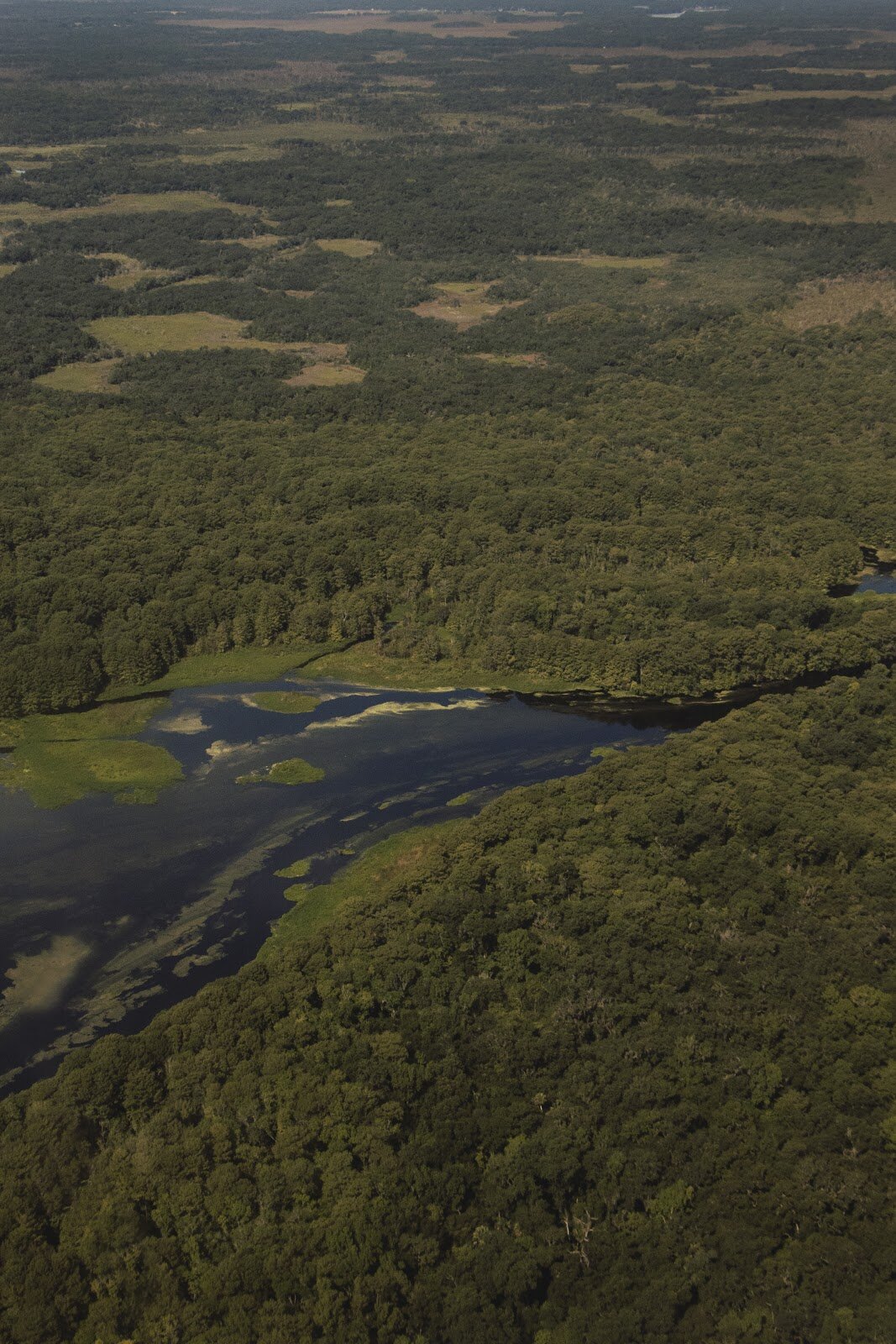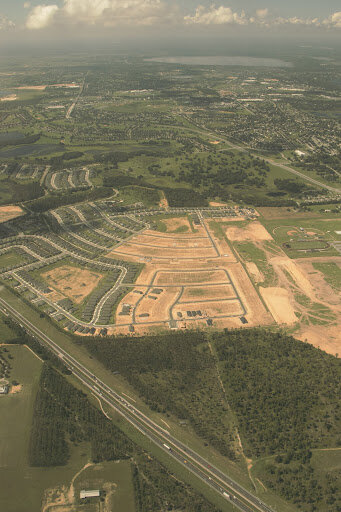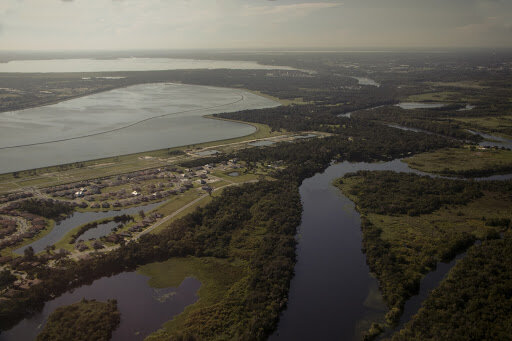The State of our State: a Bird's Eye View
View of the Silver River from above.
Article and Photos by Tanner Diberardino
Edited by Marlowe Starling
Why I loved and hated seeing Florida from above
As a college senior on the cusp of graduating with the hopes of working for an environmental nonprofit, I had admittedly become a bit cynical about my job prospects. That is, however, until I received an email from the assistant director of Conservation Florida about a possible internship. About a week after opening that email, I found myself sitting in the copilot’s seat of a plane (that I was way too large for) with Traci Deen, the executive director, and Butch Parks, the director of conservation. Quite the first day as an intern.
Traci Deen, Conservation Florida’s executive director standing with pilot, Charlie Martinez on flight day. The flight was arranged courtesy of Southwings, which is “a non-profit conservation organization that provides a network of volunteer pilots to advocate for the restoration and protection of the ecosystems and biodiversity of the Southeast through flight.”
That morning, I arrived at the hangar weightless with disbelief but weighed down by about 30 pounds of camera gear. In the lobby, Butch splayed a map over the table and reviewed our flight plan with our pilot, Charlie Martinez, as he snacked on hard-boiled eggs and told tales of his days in the Air Force. I was briefed on which areas were important to photograph, and with that we climbed into the plane. I squeezed into the front seat with Charlie and started to get my cameras and equipment ready for the flight as we taxied out to the runway.
I had flown in a small plane once before, but the experience of taking off still felt unfamiliar and exciting to an exclusively commercial flyer. As we lifted off, the plane bounced and swayed as if it were lifted by a string. I started recording on my GoPro, got my two photo cameras powered on and set up, and grabbed my video camera just in time to catch our departure from Earth.
Capturing the Views
In just seconds, the horizon emerged behind the expanse of wild Florida. The thin haze that hung over the Orlando Executive Airport earlier that morning had lifted, and we were treated to a sunny sky with only a few wispy clouds hanging in the distance. With no air-conditioning in the plane and the sun beaming in through the windows, I had to keep wiping sweat off of my camera, but it was worth it; the sun illuminated the landscape brilliantly and made my job a lot easier.
As we quickly gained altitude, the trees below multiplied into forests, houses sprouted into neighborhoods and the roads became snaking masses cutting through the land. Butch and Traci were rattling out names of rivers and forests one after the other as I snapped away, trying to keep up: the Wekiva River, St. Johns River, Lake Monroe. I tried to take as many photographs of the land as possible while also creating interesting compositions to highlight the unique beauty of this bird’s eye view.
Water from the Withlacoochee River flows into Princess Lake.
Once we reached cruising altitude at 1,200 feet, Charlie slowed and steadied the plane, and the beauty of Florida’s wilderness came into focus. The forest was split in two by the Wekiva River as it glimmered in the late morning light. Vast prairies opened up into lakes and streams, and tiny white dots came and went as airboats weaved throughout the wetlands. Seeing Florida like this truly shocked me and affirmed everything I had heard about how lush and biodiverse this state is. I was taken aback by the sheer scale of the landscape, with swamps and grasslands running for miles and miles. I remember telling Traci, “I wish everyone could see Florida from the air, because then we’d have a much easier time saving it,” and I truly meant it. Unlike the rolling hills and towering mountains of the American West, much of Florida’s beauty is tucked away behind walls of trees, invisible because of its flatness.
Seeing the Big Picture
My job on this flight wasn’t merely to photograph the amazing beauty of Florida, but also to tell the story of how that same land is under threat from overdevelopment. This is a fact that became evermore obvious as the beautiful rivers and prairies became speckled with houses and dissected by highways. Bridges of various sizes straddled rivers, roads cut through previously remote forests, and housing developments consumed patches of green, slowly choking them until there were none left. I saw trees being leveled and burned to make room for new development, while other housing developments only miles away sat baron with only a few houses having ever been built in the entire neighborhood. It was much worse than I thought.
A housing development being built near Clermont, Florida.
Cook Lake surrounded by encroaching development.
An RV resort built only a few hundred feet from the banks of the Ocklawaha River
As a lifelong Floridian, I was familiar with the high amount of development in our state, but I was wholly unaware of the scale. The same size and grandeur of the Florida wilderness that awed me minutes prior now terrified me as I saw it replaced with a congruent cluster of housing developments and highways.
Seeing the state broken up into segments by roads and developments reminded me of an article I had read years ago about the Florida panther. This segmentation breaks up the panther population into smaller groups that can’t access each other, forcing them to breed within those smaller populations. In an article for Wired Magazine, Brandon Keim explains that years of this has caused the eastern panther population to become “riddled with genetic defects and too inbred to survive much longer.'' Unfortunately, it doesn’t end with apex predators like the panthers, as habitat loss is one of the biggest threats to the variety of life on this planet. The International Union for Conservation of Nature produces the most comprehensive list of threatened species globally called the Red List, and according to the WWF, habitat loss is the primary threat to 85% of the species on the list.
Protecting Florida’s Biodiversity
This puts Florida in a particularly concerning spot. We live in one of the most biodiverse areas of the world, and also face high rates of development with nearly 29,000 new homes built last year in Orlando alone according to the Orlando Sentinel. So concerning, in fact, that the state falls within one of only 36 biodiversity hotspots in the world, which are regions home to at least 1,500 endemic vascular plants and greater than 70 percent habitat loss.
All of this information points to the fact that it is imperative that we are thoughtful and think critically about the future of Florida. We cannot continue to grow at this rate with this little foresight and expect to maintain the wild spaces that drew so many here in the first place. Developers with little-to-no accountability for the land they build on are controlling the future of Florida and shifting the landscape in ways that cause permanent damage. We must protect and conserve Florida’s wild spaces while also adapting our already developed land into places of smart and responsible growth.
The St. Johns River, Konomac Lake, and Lake Monroe (From nearest to farthest)
I feel extremely grateful and privileged to have taken that flight and to have seen Florida from this new angle. This perspective is as inspiring as it is educational; there is just as much to learn from seeing the state’s unbridled beauty as there is from seeing the destruction it faces. Efforts from groups like Conservation Florida are the reason that over nine and a half million acres of land are currently being managed for conservation, and the reason I find any solace in our state’s future. A future where we are smarter about how we manage our land, and no longer have to worry about driving countless important species towards extinction.
One of Conservation Florida's ongoing projects: Triple S Ranch
Conservation Florida is working to save Florida’s natural and agricultural landscapes – for nature, for people, forever! We work statewide to protect land that supports native plants and wildlife, fresh water, conservation corridors, family farms and ranches, the economy, and nature-based recreation. Please support conservation by making a donation today.
We would like to extend a very special “thank you” to Southwings for making this flight possible. Southwings promotes conservation through aviation.









